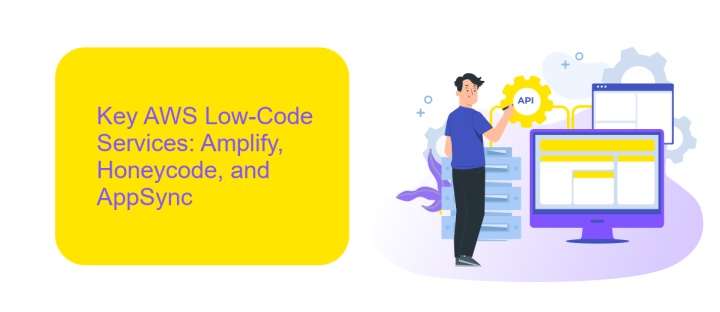AWS Low-Code
In today's fast-paced digital landscape, businesses are seeking efficient ways to develop applications without extensive coding expertise. AWS Low-Code solutions emerge as a game-changer, enabling developers and non-developers alike to rapidly create and deploy applications with minimal coding. This approach not only accelerates the development process but also empowers organizations to innovate and adapt swiftly to market demands, enhancing productivity and reducing time-to-market.
Introduction to AWS Low-Code and its Benefits
Amazon Web Services (AWS) Low-Code is a transformative approach that empowers developers and businesses to create applications with minimal hand-coding. By leveraging AWS's robust infrastructure and services, users can streamline the development process, reducing time-to-market and operational costs. The low-code platform is designed to be user-friendly, enabling both technical and non-technical users to collaborate effectively in building scalable and secure applications.
- Accelerated development: Quickly build and deploy applications with pre-built templates and components.
- Cost-efficiency: Reduce development costs by minimizing the need for extensive coding expertise.
- Scalability: Easily scale applications to meet growing business demands using AWS's cloud infrastructure.
- Enhanced collaboration: Facilitate teamwork between developers and business stakeholders through intuitive interfaces.
- Security: Leverage AWS's comprehensive security features to protect your applications and data.
Incorporating AWS Low-Code into your development strategy can significantly enhance productivity and innovation. By simplifying the application creation process, organizations can focus on delivering value and responding swiftly to market changes. Whether you're a startup or an established enterprise, AWS Low-Code offers a powerful solution to meet your digital transformation needs.
Key AWS Low-Code Services: Amplify, Honeycode, and AppSync

AWS Amplify is a comprehensive development platform that simplifies the process of building scalable mobile and web applications. It offers a suite of tools and services for both frontend and backend development, enabling developers to quickly set up authentication, storage, and APIs without deep technical expertise. With Amplify, users can integrate various AWS services seamlessly, reducing the time and effort needed to bring applications to market. For those looking to streamline integrations further, tools like ApiX-Drive can be considered to automate and connect various applications effortlessly.
Honeycode, another AWS service, empowers users to create custom applications without writing code. It provides a spreadsheet-like interface that allows teams to manage tasks, projects, and processes efficiently. Honeycode's intuitive design makes it accessible for non-developers, fostering collaboration and innovation within organizations. Meanwhile, AWS AppSync is a robust service that simplifies the development of GraphQL APIs, enabling real-time data synchronization and offline capabilities. It ensures secure and scalable data access across multiple devices. By leveraging these AWS low-code services, businesses can accelerate their digital transformation and enhance productivity.
Use Cases and Examples of AWS Low-Code Applications

AWS Low-Code solutions empower businesses to rapidly develop and deploy applications with minimal coding effort, streamlining operations and enhancing productivity. These platforms cater to various industries and use cases, providing flexibility and scalability for diverse business needs.
- Healthcare: AWS Low-Code enables the creation of patient management systems, appointment scheduling apps, and telemedicine platforms, improving patient care and operational efficiency.
- Finance: Financial institutions can leverage AWS Low-Code to build secure transaction processing systems, customer service chatbots, and compliance management tools, enhancing service delivery and regulatory adherence.
- Retail: Retailers utilize AWS Low-Code to develop inventory management systems, personalized shopping experiences, and customer feedback apps, optimizing supply chain operations and customer engagement.
By employing AWS Low-Code, businesses can significantly reduce development time and costs while maintaining high-quality standards. These applications allow non-technical users to participate in the development process, fostering innovation and collaboration across departments. As a result, organizations can quickly adapt to market changes and customer demands, ensuring a competitive edge in their respective industries.
Building a Simple Application with AWS Low-Code (Tutorial or Example)

Building a simple application with AWS Low-Code is an efficient way to harness cloud capabilities without extensive coding. AWS offers tools like AWS Amplify that streamline the development process. To start, you'll need an AWS account and basic understanding of your application's requirements.
Begin by setting up your environment. AWS Amplify provides a user-friendly interface to configure backend services such as authentication, storage, and APIs. With this setup, you can focus on the application's frontend using familiar web technologies like React, Angular, or Vue.js.
- Create a new Amplify project and initialize it.
- Use the Amplify CLI to add authentication and storage capabilities.
- Deploy the backend with a single command.
- Connect the frontend to the AWS services using Amplify libraries.
Once your application is configured, deploy it using AWS Amplify Hosting. This service simplifies hosting and provides continuous deployment capabilities. With AWS Low-Code, you can build robust applications quickly, leveraging cloud services without the complexity of traditional development.
Conclusion and Future of AWS Low-Code
The evolution of AWS Low-Code solutions marks a significant shift in how businesses approach application development, enabling rapid innovation with minimal coding effort. As organizations continue to seek ways to streamline operations and reduce development time, AWS Low-Code platforms offer an accessible and efficient means to achieve these goals. By empowering non-technical users to create and deploy applications, these solutions democratize technology and foster a culture of innovation across various sectors.
Looking ahead, the future of AWS Low-Code is promising, with ongoing advancements likely to enhance its capabilities and integration options. As more businesses recognize the value of seamless integrations, tools like ApiX-Drive will become increasingly vital, offering robust solutions for connecting diverse applications and automating workflows. The continuous evolution of AWS Low-Code platforms, combined with complementary services, will undoubtedly pave the way for more agile and adaptable business environments, enabling organizations to respond swiftly to changing market demands and technological advancements.
FAQ
What is AWS Low-Code and how does it benefit businesses?
How can I integrate AWS Low-Code solutions with other platforms?
Can AWS Low-Code tools be used for mobile app development?
What are the security features of AWS Low-Code platforms?
Is it possible to scale applications built with AWS Low-Code solutions?
Time is the most valuable resource in today's business realities. By eliminating the routine from work processes, you will get more opportunities to implement the most daring plans and ideas. Choose – you can continue to waste time, money and nerves on inefficient solutions, or you can use ApiX-Drive, automating work processes and achieving results with minimal investment of money, effort and human resources.

